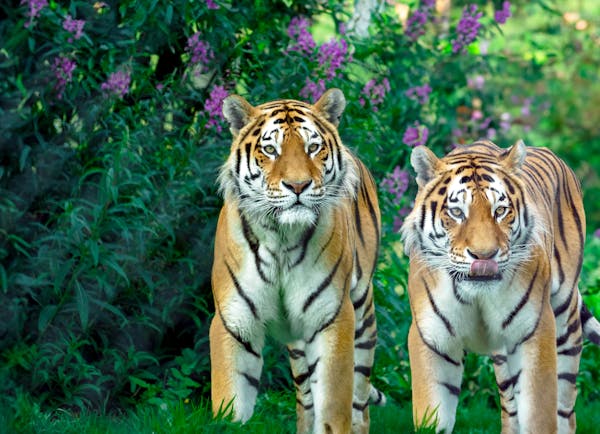Tigers are among the most majestic and fascinating creatures on the planet. As apex predators, they play a crucial role in maintaining the balance of their ecosystems. Tigers types vary significantly in terms of size, habitat, and behavior. In this guide, we will explore the different types of tigers, their unique characteristics, and why understanding them is essential for their conservation.
Table of Contents
Introduction to Tigers
Tigers are the largest members of the cat family and are known for their power and strength. Each type of tiger has unique adaptations that allow it to thrive in its specific habitat. Understanding these differences is crucial for conservationists and wildlife enthusiasts alike.
Bengal Tiger
Characteristics
The Bengal tiger, also known as Panthera tigris tigris, is perhaps the most well-known of all tiger subspecies. These tigers are primarily found in India, with smaller populations in Bangladesh, Nepal, Bhutan, and Myanmar. They are characterized by their striking orange coat with black stripes and white underbelly.
Habitat
Bengal tigers inhabit a variety of ecosystems, including grasslands, subtropical and tropical rainforests, and mangroves in the Sundarbans. Their adaptability to different environments is a key factor in their relatively larger population compared to other tiger subspecies.

Behavior
Bengal tigers are solitary animals, coming together only for mating and rearing young. They are primarily nocturnal hunters, preying on a range of animals, including deer, wild boar, and occasionally, larger prey like water buffalo.
Siberian Tiger
Characteristics
The Siberian tiger (Panthera tigris altaica), also known as the Amur tiger, is the largest of all tiger subspecies. These tigers have a paler coat compared to their southern relatives and thicker fur to withstand the harsh cold of their environment.
Habitat
Siberian tigers are native to the forests of the Russian Far East, with small populations also found in China and North Korea. They prefer dense forests with plenty of cover for stalking prey.
Behavior
Siberian tigers are known for their incredible strength and stamina. They can travel long distances in search of food and are powerful swimmers. Their diet mainly consists of deer, wild boar, and occasionally, smaller animals like rabbits and fish.
Indochinese Tiger
Characteristics
The Indochinese tiger (Panthera tigris corbetti) is slightly smaller and darker in color compared to the Bengal tiger. These tigers have narrower stripes and a more muted orange coat.
Habitat
Indochinese tigers are found in the forests of Southeast Asia, including Cambodia, Vietnam, Laos, Thailand, and Myanmar. They prefer remote, mountainous regions with dense vegetation.
Behavior
Indochinese tigers are elusive and rarely seen by humans. They are opportunistic hunters, preying on various animals, including deer, wild boar, and livestock. Their secretive nature and fragmented habitat make them one of the more challenging subspecies to study and protect.
Malayan Tiger
Characteristics
The Malayan tiger (Panthera tigris jacksoni) is a distinct subspecies found only in the southern and central parts of the Malay Peninsula. They are similar in appearance to the Indochinese tiger but slightly smaller in size.
Habitat
Malayan tigers inhabit the tropical forests of Malaysia. These areas provide ample cover and prey, although habitat loss and poaching have significantly impacted their population.
Behavior
Malayan tigers are solitary and territorial, with each individual establishing a home range that it defends from intruders. They primarily hunt at night, preying on sambar deer, barking deer, wild boar, and occasionally, smaller animals.

South China Tiger
Characteristics
The South China tiger (Panthera tigris amoyensis) is one of the most critically endangered tiger subspecies. These tigers are smaller and lighter in color, with narrower stripes compared to other subspecies.
Habitat
Historically, South China tigers roamed the forests and grasslands of southern China. However, due to habitat destruction and hunting, they are now believed to be functionally extinct in the wild, with a few individuals remaining in captivity.
Behavior
Little is known about the behavior of South China tigers in the wild due to their critically low numbers. In captivity, they exhibit typical tiger behaviors, such as solitary living and nocturnal hunting patterns.
Sumatran Tiger
Characteristics
The Sumatran tiger (Panthera tigris sumatrae) is the smallest of all tiger subspecies. They have darker fur and more prominent stripes, which help them blend into the dense jungles of Sumatra.
Habitat
Sumatran tigers are found exclusively on the Indonesian island of Sumatra. They inhabit a variety of forested areas, from lowland rainforests to mountain forests.
Behavior
Sumatran tigers are known for their agility and adaptability to various environments. They are solitary hunters, preying on deer, wild boar, and occasionally, smaller mammals. Due to their isolated habitat, they are more vulnerable to threats like deforestation and poaching.
Extinct Tiger Subspecies
Caspian Tiger
The Caspian tiger (Panthera tigris virgata) was once found in the regions surrounding the Caspian Sea. Unfortunately, this subspecies was driven to extinction in the 1970s due to habitat loss and overhunting.
Javan Tiger
The Javan tiger (Panthera tigris sondaica) lived on the Indonesian island of Java. It became extinct in the 1980s due to habitat destruction and human encroachment.
Bali Tiger
The Bali tiger (Panthera tigris balica) was the smallest tiger subspecies, found only on the Indonesian island of Bali. It became extinct in the 1940s due to hunting and habitat loss.
Conservation Efforts
Habitat Protection
Protecting the natural habitats of tigers is crucial for their survival. This includes creating and maintaining protected areas, reducing deforestation, and implementing sustainable land-use practices.
Anti-Poaching Measures
Poaching is one of the most significant threats to tiger populations. Strengthening anti-poaching laws, increasing patrols in protected areas, and raising awareness about the consequences of wildlife trafficking are essential steps in conservation.
Breeding Programs
Captive breeding programs aim to increase the population of critically endangered tiger subspecies. These programs focus on genetic diversity and the eventual reintroduction of tigers into the wild.
Community Involvement
Engaging local communities in conservation efforts is vital. Educating them about the importance of tigers and providing alternative livelihoods can reduce human-wildlife conflict and promote coexistence.
How You Can Help
Support Conservation Organizations
Many organizations are dedicated to protecting tigers and their habitats. Donating to or volunteering with these groups can make a significant impact.
Adopt a Tiger
Several conservation organizations offer symbolic tiger adoptions. This helps fund their efforts and raises awareness about the plight of these majestic animals.
Raise Awareness
Educating others about the importance of tiger conservation and the threats they face can lead to more significant collective action.
Reduce Your Carbon Footprint
Climate change and habitat destruction are closely linked. Reducing your carbon footprint by using sustainable products and supporting eco-friendly policies can help preserve tiger habitats.

The Ecological Role of Tigers
Tigers are apex predators, meaning they sit at the top of the food chain in their ecosystems. Their presence helps maintain the balance of the natural environment. By controlling the populations of herbivores such as deer and wild boar, tigers ensure that vegetation is not overgrazed, which in turn maintains the health and diversity of forests and grasslands. This balance supports a variety of other wildlife species, from small mammals to birds and insects, contributing to a rich and diverse ecosystem.
Economic and Cultural Significance
Beyond their ecological role, tigers have significant cultural and economic importance. In many Asian cultures, tigers are revered symbols of power, strength, and courage. They feature prominently in folklore, mythology, and traditional art. Protecting tigers also has substantial economic benefits, particularly through eco-tourism. Countries like India and Thailand attract millions of tourists annually who come specifically to see these magnificent animals in the wild. This tourism generates vital revenue for local communities and supports broader conservation efforts.
Threats to Tiger Populations
Despite their importance, tigers face numerous threats that have led to a dramatic decline in their populations over the past century. Habitat loss is one of the most pressing issues. Expanding agricultural land, logging, and infrastructure development have fragmented and destroyed large areas of tiger habitat. This not only reduces the available territory for tigers but also isolates populations, making it harder for them to find mates and maintain genetic diversity.
Poaching is another critical threat. Tigers are hunted for their skins, bones, and other body parts, which are highly valued in traditional medicine and as status symbols. Illegal wildlife trade is a multi-billion-dollar industry that continues to thrive despite international bans and stringent laws. Combatting poaching requires a multi-faceted approach, including stronger law enforcement, better patrolling of protected areas, and reducing demand for tiger products through education and awareness campaigns.
Human-wildlife conflict also poses a significant challenge. As human populations grow and encroach on tiger habitats, encounters between tigers and people become more frequent. Tigers may prey on livestock, leading to economic losses for farmers and retaliatory killings of tigers. Implementing measures such as secure livestock enclosures, community-based conservation programs, and compensation schemes for losses can help mitigate these conflicts.
Innovative Conservation Strategies
Innovative strategies are being developed and implemented to address the complex challenges of tiger conservation. One such approach is the use of technology, including camera traps, drones, and GPS collars, to monitor tiger populations and their movements. These tools provide valuable data that helps conservationists track the health of tiger populations, understand their behaviors, and identify critical areas for protection.

Community involvement is also crucial. Conservation programs that engage local communities and provide them with alternative livelihoods can reduce dependence on activities that harm tigers, such as poaching and habitat destruction. For example, eco-tourism initiatives can provide income for communities while incentivizing the preservation of natural habitats and wildlife.
International cooperation is another key element of successful tiger conservation. Many tiger habitats span national borders, requiring countries to collaborate on strategies for habitat protection, anti-poaching efforts, and genetic diversity management. Initiatives such as the Global Tiger Initiative (GTI) and the Tx2 program, which aims to double the wild tiger population by 2022, are examples of how international collaboration can enhance conservation efforts.
The Future of Tigers
The future of tigers depends on the collective efforts of governments, conservation organizations, local communities, and individuals. While the challenges are significant, there are also many reasons for optimism. Success stories, such as the recovery of the Bengal tiger population in India and the recent sightings of tigers in areas where they were thought to be extinct, demonstrate that with concerted effort and innovative strategies, it is possible to reverse the decline of tiger populations.
Each of us can play a part in this vital mission. By supporting conservation initiatives, raising awareness, and making sustainable choices, we contribute to a future where tigers can thrive in the wild. Preserving these magnificent creatures is not just about saving a single species; it is about maintaining the health of entire ecosystems and preserving the natural heritage for future generations.
Conclusion
Understanding the types of tigers and the unique challenges each subspecies faces is crucial for their conservation. By learning about these magnificent creatures and supporting efforts to protect them, we can ensure that future generations will continue to witness the beauty and majesty of tigers in the wild.




























































